


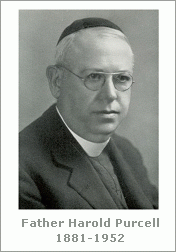
|
Father Harold Purcell was born in Raven Run, Pennsylvania, in 1881.
After his father's death he was raised in Philadelphia.
There young Tom attended a
Passionist
mission at his home
parish of St. Columba. Attracted by the missionaries, he
entered the Passionist Prep School at Dunkirk. A year later
he entered the novitiate year at historic St. Paul's monastery
in Pittsburgh. He was given the name Harold at his profession
of vows in 1898. In 1904 he was ordained. Two years later he began his ministry as a parish missionary. For five years he was assigned to help the Western province by conducting missions there. He then returned to the East where he continued his full schedule of parish missions. These years of preaching in almost every part of the country showed him the strengths and weaknesses of the Church in the United States. As early as November, 1911, while giving a mission at St. Mary's Church in Huntington, Indiana, he met the young pastor, Father John F. Noll. Father Noll (later bishop) had just begun a parish newspaper to help his parishioners find answers for their faith. This parish paper soon became the national paper, Our Sunday Visitor. At once Father Harold saw the possibilities of the apostolate of the press for his own Passionist community. When he was asked in 1919 to speak at St. Michael's church in Union City on the establishment of the Confraternity of the Passion there, he took the occasion to describe the need for a Catholic magazine to support the membership of the new Confraternity. The religious began to discuss whether this was an appropriate apostolate for Passionists. In the following year he got a classmate who was a member of the forthcoming provincial chapter to present a resolution to the chapter concerning the publishing of a religious magazine. The chapter passed the resolution. In March of 1921 the Provincial asked Father Harold to begin such a magazine. The first copy was published in July, 1921. It was called The Sign and under Father Harold's direction became an instant success. Father Harold did not make it just a pious journal for the Confraternity. Nor was it planned to be just a "mission magazine" although it did support the new mission in China and did inform its readers of the activities of the "Passionists in China." From the beginning it was a magazine on Catholic life and social teaching. The production of a professional magazine such as The Sign soon demanded of the staff and editor time and work. Furthermore, as Father Harold wrote or published articles on social issues, he became convinced that the most important issue in the United States was the racial question. He was in contact with Dorothy Day, Father John Lefarge, S.J., and other activists of the depression years. Father Harold began to dream of establishing in the south "a center for the religious, charitable, educational and industrial advancement of the Negro people." He called it the "City of St. Jude." (Note: During 1952 Hank Williams was a frequent patient at St. Jude's Hospital) In March 1934 Bishop Thomas J. Toolen of Mobile, Alabama, met Father Harold and his friends. He invited Harold to build "his city" at Montgomery in the Mobile diocese. Harold at once wrote to the Provincial, Father Benjamin Wirtz, asking permission to go to Alabama. After some time the answer came: "No!" For several months Harold pondered what to do. Finally he requested a dispensation from his vows which was granted on July 28, 1934. He left the community and became a member of the diocesan priests of the diocese of Mobile. The Passionist superiors decided that such a project as the City of St. Jude was not in conformity with the spirit of St. Paul of the Cross. We are reminded of the dream of Father Martin Byrne in Argentina in 1879. He was expelled from the congregation and then readmitted by the Holy See. Harold sought a dispensation, fulfilled his dream, but in many ways remained a Passionist in spirit. Father Harold's story highlights the problems that were facing the congregation in the United States at this time. It is important to reflect that Passionists had entered upon some of these ministries and programs, not at the initiative of an individual, but with the blessings and even decisions of the superiors and chapters. |


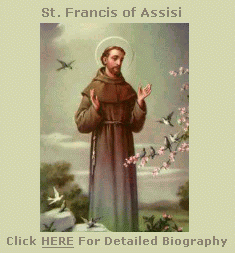



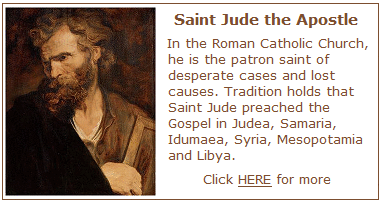


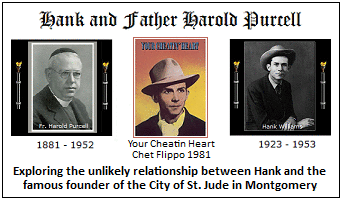

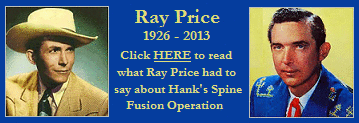


 Click
HERE for UPDATES on Hank's 50th Anniversary events in Germany
Click
HERE for UPDATES on Hank's 50th Anniversary events in Germany Click
HERE and view a Photo of above mentioned German 'Hank' Event
Click
HERE and view a Photo of above mentioned German 'Hank' Event
 Click HERE and read: "MY FASCINATION FOR HANK WILLIAMS" written
Click HERE and read: "MY FASCINATION FOR HANK WILLIAMS" written  Click
HERE to view a 2013 Photo of Mr. Reinhardt receiving a certificate
Click
HERE to view a 2013 Photo of Mr. Reinhardt receiving a certificate Click HERE to view our collection of RARE HANK WILLIAMS POSTERS & HANDBILLS
Click HERE to view our collection of RARE HANK WILLIAMS POSTERS & HANDBILLS






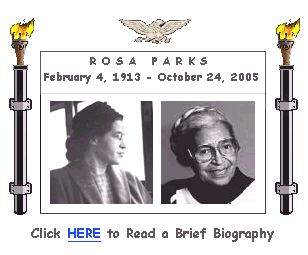
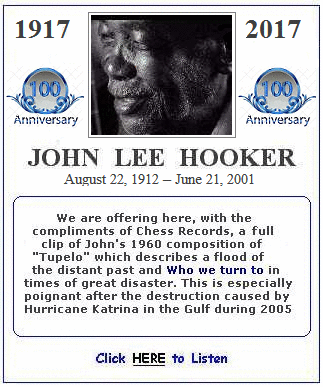
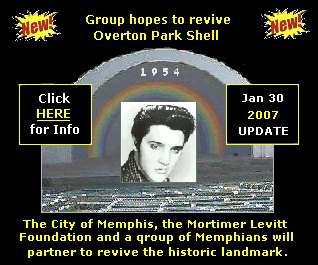



 Email: Web Administration wwwebmonitor@yahoo.com
Email: Web Administration wwwebmonitor@yahoo.com 
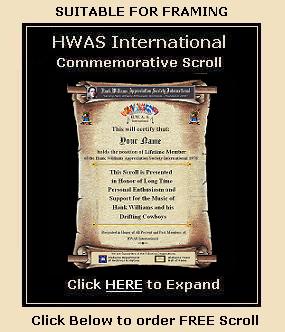

 Click HERE and read a Brief History of the
Click HERE and read a Brief History of the Click HERE and read the nice letter to HWAS
Click HERE and read the nice letter to HWAS Click
HERE to View HWAS Membership POSTER
Click
HERE to View HWAS Membership POSTER Click
HERE to View: HWAS Membership TEXT FILE
Click
HERE to View: HWAS Membership TEXT FILE Click
HERE and View a HWAS Membership TEXT FILE
Click
HERE and View a HWAS Membership TEXT FILE Click
HERE to View the HWAS Membership Applications
Click
HERE to View the HWAS Membership Applications




